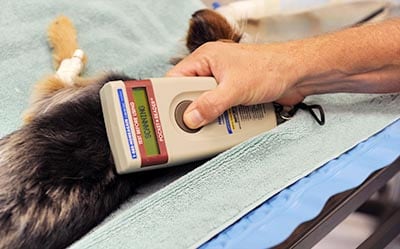Care First Partners With SPCA of Wake County for ‘National Check the Chip Day’
August 09, 2019
Why Should I Microchip My Pet?

In North Carolina alone, thousands of pets are lost each year and never find their way back home. We know how much you love your pet and would never want this to happen. In the case that it does, the best chance you can give your pet is to make sure they have a microchip. We understand that deciding whether or not to microchip your pet isn’t a small decision, which is why we want to make sure all your questions are answered.
What is a Microchip?
A microchip is a very small radio-frequency identification transponder that stores a unique ID number and is inserted into a pet. From the ID number, the pet owner’s contact information can be pulled.
What are the benefits of a Microchip?
1. Doesn’t Fall Off
Collars and dog tags are great to have for your pet, but unfortunately, it is easy for them to come off. If your pet is lost, it is likely that the collar or tag will become stuck on something and fall off. A microchip, on the other hand, is inserted into your pet so that it cannot be removed.
2. Reunites Your Pet
If your pet is lost and is taken into an animal shelter or vets office, the first thing the vet will do is check for a microchip. If your pet has a microchip, then the vet will be able to contact the owner and work on getting the pair reunited again.
3. Settles Ownership Disputes
In cases of ownership disputes, a microchip will help you prove that the animal is your pet. You will be able to rest assured that your pet is marked as yours, with or without a collar.
4. Lasts a Lifetime
While collars can be taken off, fade or fall off, microchips last the entirety of your pet’s life. You won’t ever have to re-do the microchip, and you can enjoy the peace of mind that comes with the chip. Even though it lasts a lifetime, it is important that the information on the microchip is kept up to date. If the address or contact information has changed, the owner should call the microchip company and update the information.
Will the microchip hurt when it is inserted?
The tool that inserts the microchip is a large needle, which causes a slight pinching feeling. Most animals do not even react while getting microchipped.
What age is recommended for a microchip?
A microchip can be inserted as early as 8 weeks and can also be done any time after no matter the pet’s age.
Where is the microchip inserted?
Microchips are inserted between the shoulder blades of your pet.
Are microchips expensive?
The cost of a microchip varies but is usually between $40 and $100, which can sometimes deter pet owners. Because of this, Care First is a proud partner with the SPCA of Wake County in their Chips for Change initiative.
Chips for Change

The Chips for Change initiative allows pet owners to pay for the microchip with what they can afford. Our goal is to change the future of lost pets in our community by providing pet owners with an easy way to microchip their pets. To get started, fill out a form and our team will reach out to you.
Donating to Chips for Change
Donating to the Chip for Change cause helps pet owners who are unable to afford microchips, and in turn aids in the effort to lower the number of lost animals in North Carolina. If you would like to donate, click here.
Talk To Us About Microchipping
August 15th is National Check the Chip day, so the time to chip is now! If you would like to learn more about microchipping or the Chips for Change cause, contact Care First Animal Hospital today.

